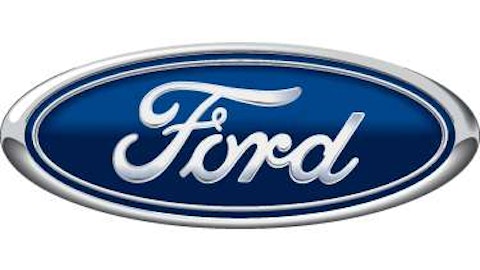The only way to consistently get stocks at low prices is to buy them at a bargain of their true value. With Ford Motor Company (NYSE:F) currently trading at only 10.67 times its earnings, it appears cheap — but is it a true bargain?
To answer this question, let’s see how Ford holds up to some tried-and-true bargain-identifying criteria, as provided by the father of value investing, Ben Graham. For comparison’s sake, we’ll look at Ford’s performance side by side with one of its closest American competitors, General Motors Company (NYSE:GM) .

Ford’s facts
Let’s see how Ford Motor Company (NYSE:F) holds up to some of Graham’s standards of a bargain purchase for the intelligent investor.
Strong financial condition
| Metric | Ford | General Motors |
|---|---|---|
| Current Ratio (MRQ) | 2.80 | 1.30 |
| Net Current Assets to LT Debt (MRQ) | 0.77 | 0.23 |
Source: Fool.com
To ensure financial stability, Graham recommended that companies to have a current ratio (current assets divided by current liabilities) of at least 2.0, and net current assets (working capital) that exceed long-term debt. Neither company meets the latter requirement, although Ford comes the closest. Ford is also the only one to boast a current ratio of at least 2.0, establishing itself as the more financially stable pick of the two.
Stable earnings
| Metric | Ford | General Motors |
|---|---|---|
| Net Loss in Prior 10 years? | Yes | N/A |
| Net Loss in Prior 5 years? | Yes | N/A |
Source: Each company’s 10-K filings.
Graham also recommended that companies show no loss in each of the past 10 years. Unfortunately, neither company was able to achieve this, because of tough economic times from 2008-2009. Even when evaluating the companies with Graham’s relatively lax enterprising investor criterion of no loss in each of the past five years, both fail to deliver.
Dividend record
| Metric | Ford | General Motors |
|---|---|---|
| Uninterrupted Dividend for Past 20 years? | No | N/A |
| Current Dividend | $0.40 | N/A |
Sources: dividata.com & Fool.com.
Graham suggested that a company should have uninterrupted dividends for the past twenty years. Again, neither company meets this objective, though Ford Motor Company (NYSE:F) at least has some history of dividends, and boasts a current (and modest) payout of $0.40.
Earnings growth
| Metric | Ford | General Motors |
|---|---|---|
| 10-Year Earnings Growth? | Yes | N/A |
Source: Each company’s 10-K filings (calculated by comparing the three-year average of EPS at the beginning and end of the most recent 10-year period).
To ensure that his bargain finds were not cheap because of their poor quality, Graham looked for companies that grew their earnings by at least one-third in the past 10 years. Ford Motor Company (NYSE:F) was able to achieve this by increasing its 2000-2002 average (diluted) EPS of negative $0.42 to the 2010-2012 average of $2.67. General Motors Company (NYSE:GM) doesn’t have 10 years of comparable data available, given its 2009 reorganization.
Favorable price to earnings
| Metric | Ford | General Motors |
|---|---|---|
| Today’s P/E | 10.39 | 11.71 |
| Graham’s P/E | 5.87 | 9.86 |
Source: Fool.com & each company’s 10-K filing (Graham’s P/E ratio calculated as today’s price divided by the average earnings for the most recent three years).
For an adequate margin of safety, Graham sought out companies that had current prices less than 15 times average earnings for the past three years. It is here that both Ford and General Motors Company (NYSE:GM) shine the most, with very attractive price to earnings, as well as price to average earnings well within Graham’s prescribed range.
Favorable price to book value
| Metric | Ford | General Motors |
|---|---|---|
| Price to Book (MRQ) | 3.49 | 1.72 |
| Product | 20.49 | 16.96 |
Source: Fool.com (Product figure calculated as the product of price to book and Graham’s price to earnings).
Graham considered companies to be well-priced if the product of the price-to-book and price-to-earnings ratios was below 22.5 (Graham’s price-to-earnings criteria of 15 times his price-to-book criteria of 1.5). Ford Motor Company (NYSE:F) and General Motors Company (NYSE:GM) both pass this criterion as well, demonstrating very attractive prices yet again.
The bottom line
So what does all this mean? Is Ford’s price truly a bargain, or is it just cheap? If you are a highly risk-averse investor looking for an ultra-safe investment, Ford may not be the stock for you. It fails to completely pass all of Graham’s stringent criteria for a safe, bargain purchase.
However, if you can afford some level of risk and have a well-diversified portfolio, Ford Motor Company (NYSE:F) could make for a great investment. Although it generated a net loss in the prior 10 years (during a recession), it has since performed well in terms of its earnings growth and still has much to gain when the market fully recovers.
Given its possibilities for growth, and Ford’s relatively stable financial condition, there’s simply no reason it should be priced as low as it is. With its stock trading at only 10.67 times current earnings and 5.87 times its average earnings for the most recent three years, Ford is definitely a bargain.
Matthew McMichen has no position in any stocks mentioned. The Motley Fool recommends Ford and General Motors Company (NYSE:GM). The Motley Fool owns shares of Ford Motor Company (NYSE:F).
The article Is Ford as Cheap as It Seems? originally appeared on Fool.com.
Matthew is a member of The Motley Fool Blog Network — entries represent the personal opinion of the blogger and are not formally edited.
Copyright © 1995 – 2013 The Motley Fool, LLC. All rights reserved. The Motley Fool has a disclosure policy.



